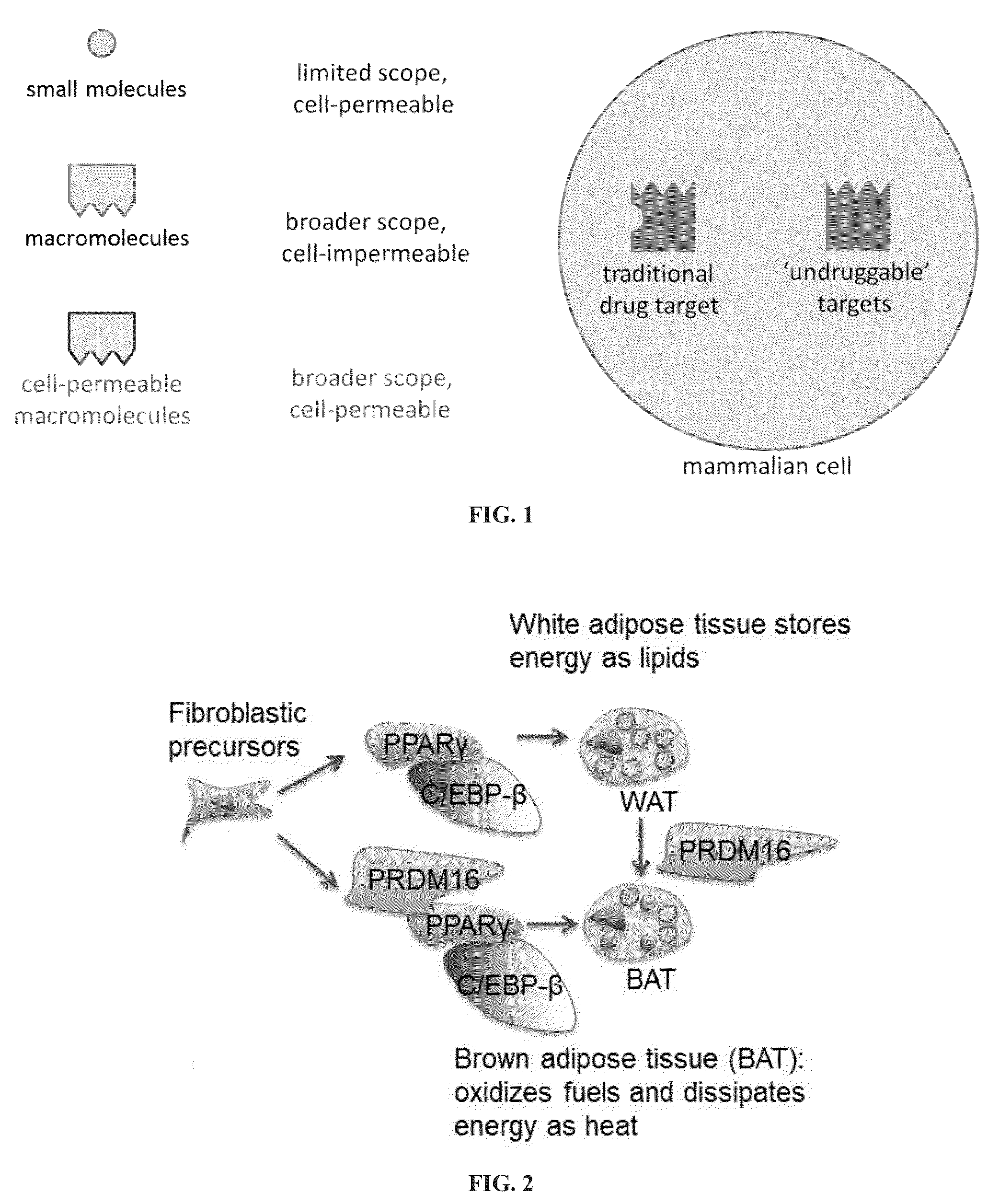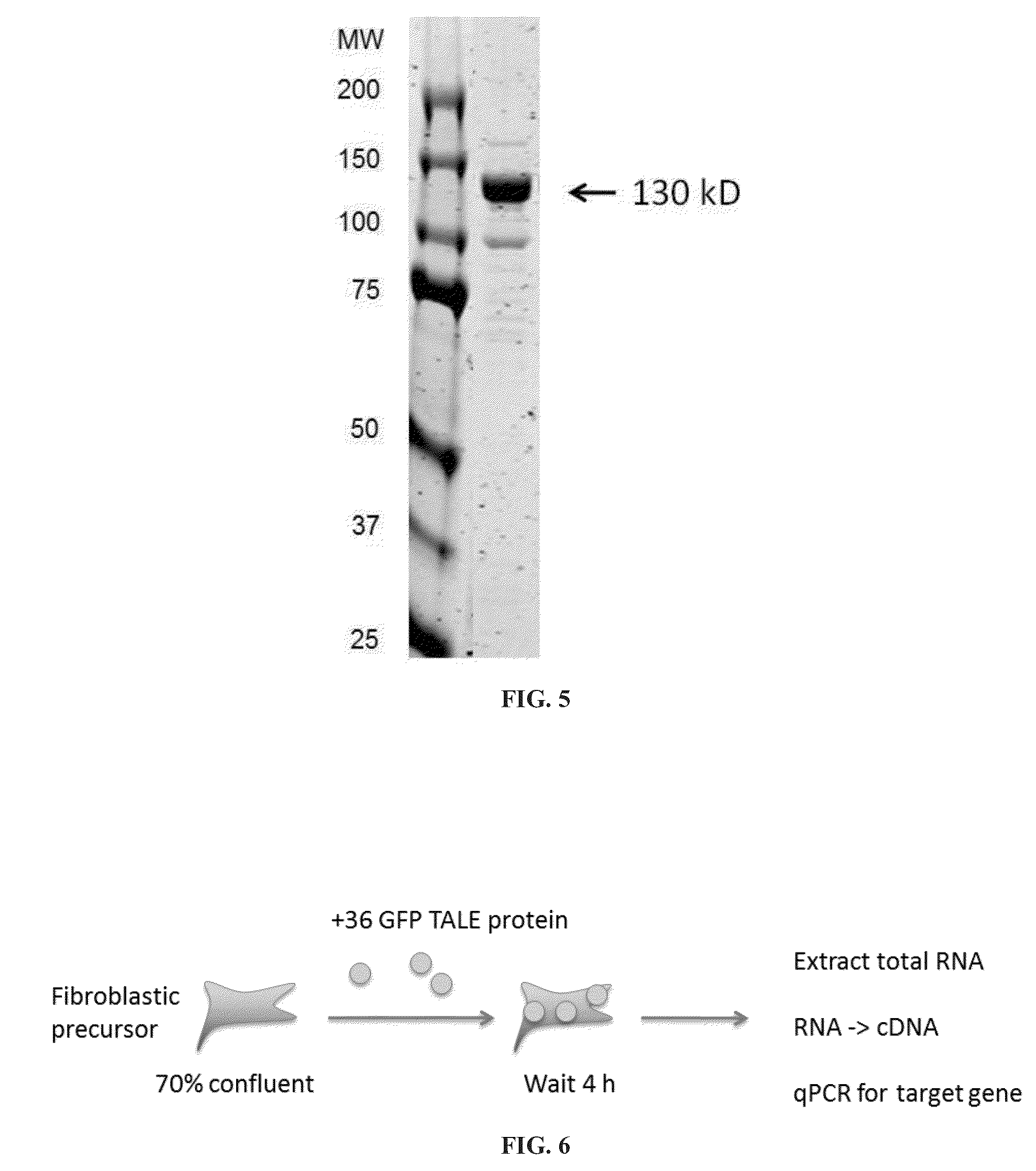Use of cationic lipids to deliver cas9
a technology of cationic lipids and cas9, which is applied in the direction of peptides, enzymology, drug compositions, etc., can solve the problems of long-term exposure to the encoded agent, the possibility of permanent recombination into the genome, and the inability to address intracellular targets
- Summary
- Abstract
- Description
- Claims
- Application Information
AI Technical Summary
Benefits of technology
Problems solved by technology
Method used
Image
Examples
example 1
Delivery of TALE Activators Fused to Supercharged GFP
[0218]A major target for reprogramming fibroblast cell fate towards brown or white adipocyte cell fate lies in the switch from White Adipose Tissue (WAT) to Brown Adipose Tissue (BAT), which is governed by expression of PRDM16 and PPARγ. Robust TALE transcriptional activators fused to a +36 GFP were engineered that target PPARγ and PRDM16 genomic sequences in fibroblasts. Fusion proteins were purified using a heparin column and / or an SEC and gels show a single band at 130 kD The modulation of expression and effect on cellular phenotype after delivery of the TALE activators was compared to the modulation after viral delivery of a PPARγ cDNA followed by 7-day treatment with adipogenesis cocktail. It was observed that adipocytes formed upon treatment with +36 GFP TALEPRDM16 fusion. Expression of white adipose tissue marker genes was detected after delivery of supercharged PRDM16 TALE activators.
[0219]A one-time supercharged protein-m...
example 2
In Vivo Delivery of TALE Activators Fused to Supercharged GFP
[0224]NIH 3T3 cells were grown to 70-90% confluence and treated with 1 μM or between 0.5-5 μM of +36 GFP PPARγ TALE and / or +36 GFP PRDM16 TALE fusion protein in DMEM without serum. A serum-free medium was chosen, because serum can decrease the effectiveness of protein-based delivery. Cells were incubated with the respective fusion protein solution for 4 hours before the media was removed and full DMEM containing serum was added back to cells. Control cells were infected with a viral contruct encoding PPARγ or PRDM16 in order to serve as a positive control for expression of WAT and BAT genes according to known protocols (see, e.g., Seale et al. 2008 Nature 454, 961-967, the entire contents of which are incorporated herein by reference). Once all cells reached 100% confluence an adipogenesis cocktail containing isobutylmethylxanthine, insulin, rosiglitazone, dexamethosone, T3, and indomethacin was added to the cells and repl...
example 3
Delivery of TALE Activators Complexed with Supercharged GFP
[0226]In order to improve delivery efficacy, protein complexes in which the functional protein was non-covalently associated with the supercharged protein were generated and administered to cells. FIG. 21. shows that delivery of functional TALE activator fusion proteins as complexes with +36 GFP improves TALE activator activity after delivery. FIG. 22 shows PRDM16 gene expression after TALE activator fusion delivery either as a fusion (+36GFP PRDM16 TALE-3) or a complex (+36GFP+PRDM16 TALE-3) with +36GFP. It was observed that delivery of complexes tended to increase TALE activator activity.
PUM
| Property | Measurement | Unit |
|---|---|---|
| volume | aaaaa | aaaaa |
| volume | aaaaa | aaaaa |
| composition | aaaaa | aaaaa |
Abstract
Description
Claims
Application Information
 Login to View More
Login to View More - R&D
- Intellectual Property
- Life Sciences
- Materials
- Tech Scout
- Unparalleled Data Quality
- Higher Quality Content
- 60% Fewer Hallucinations
Browse by: Latest US Patents, China's latest patents, Technical Efficacy Thesaurus, Application Domain, Technology Topic, Popular Technical Reports.
© 2025 PatSnap. All rights reserved.Legal|Privacy policy|Modern Slavery Act Transparency Statement|Sitemap|About US| Contact US: help@patsnap.com



